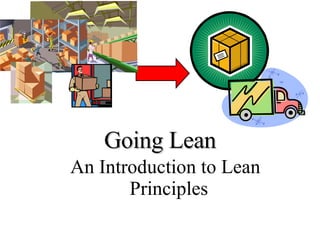Hourly Lean Introduction
•Télécharger en tant que PPT, PDF•
26 j'aime•5,969 vues
This is a little presentation we used for our hourly employees when we rolled out lean. Not attached are the real life examples we discussed as part of the training.
Signaler
Partager
Signaler
Partager

Recommandé
Contenu connexe
Tendances
Tendances (20)
"Visual management & 5S " in Lean T.P.S (Workshop slides)

"Visual management & 5S " in Lean T.P.S (Workshop slides)
En vedette
En vedette (20)
Relay baton - Good example of one piece continous flow

Relay baton - Good example of one piece continous flow
Lean Culture (What is it, Why do we want it, How do we get it)

Lean Culture (What is it, Why do we want it, How do we get it)
How to develop managers able to lean and sustain end to-end value streams

How to develop managers able to lean and sustain end to-end value streams
Similaire à Hourly Lean Introduction
Similaire à Hourly Lean Introduction (20)
Dernier
Best Practices for Implementing an External Recruiting Partnership

Best Practices for Implementing an External Recruiting PartnershipRecruitment Process Outsourcing Association
Dernier (20)
The Coffee Bean & Tea Leaf(CBTL), Business strategy case study

The Coffee Bean & Tea Leaf(CBTL), Business strategy case study
VIP Call Girls In Saharaganj ( Lucknow ) 🔝 8923113531 🔝 Cash Payment (COD) 👒

VIP Call Girls In Saharaganj ( Lucknow ) 🔝 8923113531 🔝 Cash Payment (COD) 👒
Sales & Marketing Alignment: How to Synergize for Success

Sales & Marketing Alignment: How to Synergize for Success
MONA 98765-12871 CALL GIRLS IN LUDHIANA LUDHIANA CALL GIRL

MONA 98765-12871 CALL GIRLS IN LUDHIANA LUDHIANA CALL GIRL
Grateful 7 speech thanking everyone that has helped.pdf

Grateful 7 speech thanking everyone that has helped.pdf
Best Practices for Implementing an External Recruiting Partnership

Best Practices for Implementing an External Recruiting Partnership
Insurers' journeys to build a mastery in the IoT usage

Insurers' journeys to build a mastery in the IoT usage
The CMO Survey - Highlights and Insights Report - Spring 2024

The CMO Survey - Highlights and Insights Report - Spring 2024
Regression analysis: Simple Linear Regression Multiple Linear Regression

Regression analysis: Simple Linear Regression Multiple Linear Regression
Mysore Call Girls 8617370543 WhatsApp Number 24x7 Best Services

Mysore Call Girls 8617370543 WhatsApp Number 24x7 Best Services
Call Girls in Gomti Nagar - 7388211116 - With room Service

Call Girls in Gomti Nagar - 7388211116 - With room Service
Keppel Ltd. 1Q 2024 Business Update Presentation Slides

Keppel Ltd. 1Q 2024 Business Update Presentation Slides
Call Girls Pune Just Call 9907093804 Top Class Call Girl Service Available

Call Girls Pune Just Call 9907093804 Top Class Call Girl Service Available
Lucknow 💋 Escorts in Lucknow - 450+ Call Girl Cash Payment 8923113531 Neha Th...

Lucknow 💋 Escorts in Lucknow - 450+ Call Girl Cash Payment 8923113531 Neha Th...
Hourly Lean Introduction
- 1. Going Lean An Introduction to Lean Principles
- 10. Inventory Hides Waste Sea of Inventory Long Transportation Communication Problems Machine Downtime Employee Availability Poor Scheduling Quality Problems Line Imbalance Long Setups Supplier issues House Keeping Employee Availability Finished Goods Raw Materials
- 11. Reducing Inventory Uncovers Opportunities to Improve Opportunities Converted into Cash!
- 12. Walking without working; searching for tools, materials or information; reaching, bending or unnecessary motion due to poor housekeeping or workplace layout Motion Double or triple handling, moving in and out of storage areas and warehouses, poor layouts, poor housekeeping Transportation Watching machines run or cycle, waiting for parts, instructions, approval, information, maintenance or decisions Waiting
- 13. A source of labor only, not seen as true process experts; do not involve in finding solutions People’s Skills Defective or scrap materials, OOS control processes, low yield, incorrect schedules, engineering documents or information Defects Repair or rework steps, extra setup steps, over-specification of the process, extra processing steps Process
- 16. A value stream is all of the value-adding activity AND all of the non-value adding activity (pure waste and incidental waste) required to provide a product/service to a customer 2. Map the Flow of Value in Our Cell Process A Process B Process C Raw Material Customer Finished Product Value Stream
- 18. 3. Make Value Flow in Our Cell Continuous Flow - Make One - Move One Batch Processing How long to make a pack of 10 units? How long to make a pack of 10 units?
- 19. 4. Establish Pull from Our Cell’s Customer(s) Okay! One more please! Customer Supplier
- 20. 5. Seek Perfection in Our Cell PDCA
- 21. Lean Tools
- 32. Recap
- 34. Lean Emphasis Resource distribution Opportunity for improvement by reducing waste and creating additional value Value Waste Initial Process Value Waste General Process Reduction Waste and Value Both Decrease Waste Only Reduction Value Waste Target & Reduce Waste Maintain Value Value Maintained Resources Decrease Value Creation Value Waste Apply Resources to Create More Value Value Increased Resources Focused
- 36. Expected Lean Results Costs Defects (99%) Inventory (10 fold) Lead Time (90%) Machine Downtime Space (50%) Capacity Customer Responsiveness Efficiency Employee Satisfaction Flexibility – Demand Flux
